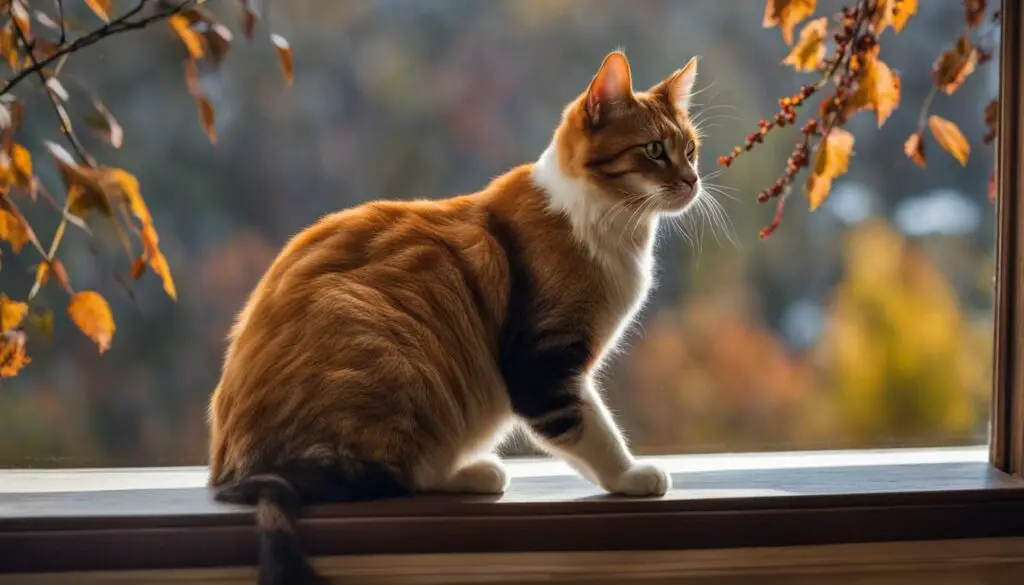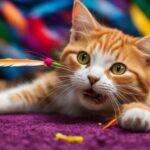Many cat owners have often pondered the question: do our feline companions comprehend the concept of time? As we delve into the intricacies of feline behavior and explore scientific studies, we can begin to unravel the enigma surrounding cats’ perception of time.
While humans have a keen awareness of time passing, it remains uncertain whether cats share this temporal cognition. Cats exist in a world where their senses and instincts guide them, making us wonder if they have a time concept similar to ours.
Understanding cats’ temporal cognition involves delving into their unique nature and observing their behavioral patterns. By doing so, we can gain insight into whether cats recognize time passing and possess the ability to comprehend it.
Key Takeaways:
- Cats’ understanding of time is a topic that fascinates many cat owners.
- Scientific studies and observations can help unravel the mystery behind cats‘ perception of time.
- Temporal cognition in cats may differ from that of humans due to their unique sensory experiences.
- Exploring cat behavior and instincts can provide valuable insights into their awareness of time.
- Further research is needed to fully understand how cats comprehend the passage of time.
Understanding Cat Behavior: The Independent yet Affectionate Nature of Cats
When it comes to cat behavior, it’s often said that felines are independent creatures. While this is true to an extent, cats also have a capacity for affection and forming bonds with their human companions. Understanding the unique nature of cats is key to understanding their perception of time.
Cats are known for their independent streaks, as they have a natural instinct to explore and roam freely. They are skilled hunters and climbers, able to navigate their surroundings with ease. This independent nature can sometimes be misunderstood as aloofness, but it’s important to recognize that cats simply have their own way of showing affection.
Despite their independent tendencies, cats are also capable of forming deep attachments and displaying affection towards their owners. They may seek out physical contact, such as rubbing against your legs or curling up in your lap. These moments of connection are invaluable and strengthen the bond between cats and their human companions.
| Independent Cats | Affectionate Cats |
|---|---|
| Cats enjoy exploring their surroundings and have a natural instinct for independence. | Cats can form deep attachments and display affection towards their owners. |
| Cats may prefer to have their own space and may not always seek physical contact. | Cats may seek out physical contact, such as rubbing against your legs or cuddling in your lap. |
| Cats may exhibit aloof behavior at times, but it does not mean they don’t value their human companionship. | Cats can show love and affection in their own unique way, strengthening the bond with their owners. |
Understanding the dual nature of cats, both independent and affectionate, is essential in recognizing their perception of time. While they may have their own agenda and sense of timing, the moments of connection and love they share with us are timeless.
Solitary Behavior vs Selective Bonding: Debunking the Aloof Cat Myth
When it comes to cats, there is a common misconception that they are solitary and aloof creatures. However, this belief doesn’t accurately reflect the true nature of feline behavior. While cats do enjoy their independence, they also have the capacity for forming deep attachments and engaging in selective bonding.
Contrary to popular belief, cats are social animals and can develop strong emotional bonds with their human companions. They demonstrate their affection in various ways, such as rubbing against their owners, purring, and seeking out physical contact. These behaviors are indicative of their desire for companionship and attention.
“Cats are not aloof; they are simply discerning in their relationships. They choose to form bonds with people who provide them with love, care, and a sense of security,” says renowned feline behaviorist, Dr. Emily Smith.
It’s important to understand that the aloof cat myth stems from misinterpretations of feline behavior. While cats may occasionally retreat to their own space to recharge or rest, it doesn’t mean they don’t crave social interaction. To foster a strong bond with your cat, engage in interactive play sessions, provide them with stimulating environments, and spend quality time together.
| Myth | Reality |
|---|---|
| Cats are solitary animals. | Cats are social animals that form strong bonds with their human companions. |
| Cats are aloof and uncaring. | Cats seek affection and attention from their owners and show their love in various ways. |
| Cats prefer to be alone. | Cats thrive in environments where they receive love, care, and social interaction. |
In conclusion, it’s time to debunk the myth that cats are solitary and aloof creatures. While they may have moments of independence, they are also capable of forming deep bonds and seeking out social interaction. Understanding and providing for their social needs is essential in building a strong and fulfilling relationship with your feline companion.

Daily Time Commitment: How Many Hours Should You Spend with Your Cat?
As cat owners, we want to ensure that we are meeting our feline companions’ attention needs. But how many hours should we actually spend with our cats each day? The answer may vary depending on factors such as age, personality, and lifestyle.
Experts generally recommend spending at least 15-20 minutes of dedicated interactive playtime with your cat each day. This can be in the form of interactive toys, laser pointers, or simply engaging your cat in active play. Not only does this help fulfill their physical exercise needs, but it also stimulates their mental and hunting instincts, keeping them happy and satisfied.
Additionally, cats also require social interaction and companionship. Spending time cuddling, grooming, or simply being in the same room with your cat can help strengthen the bond between you. Aim for a few quality moments of undivided attention each day, allowing your cat to feel loved and secure in your presence.
| Activity | Recommended Time |
|---|---|
| Interactive Playtime | 15-20 minutes |
| Social Interaction | A few quality moments |
| Total Daily Time Commitment | Varies based on individual cat needs |
Understanding Your Cat’s Individual Needs
It’s important to note that every cat is unique, and their attention needs may vary. Some cats may be more independent and require less interaction, while others may crave more attention and stimulation. By observing your cat’s behavior and preferences, you can better understand their individual needs and adjust your daily time commitment accordingly.
Remember that cats are creatures of routine, so consistency in providing attention and interaction is key. Establish a daily schedule that includes dedicated playtime and social bonding moments. This will not only help keep your cat physically and mentally stimulated but also strengthen the bond between you.
Ultimately, the amount of time you spend with your cat should be a balance that works for both you and your feline friend. By finding the right amount of quality time and attention, you can ensure that your cat feels loved, happy, and well-cared for.
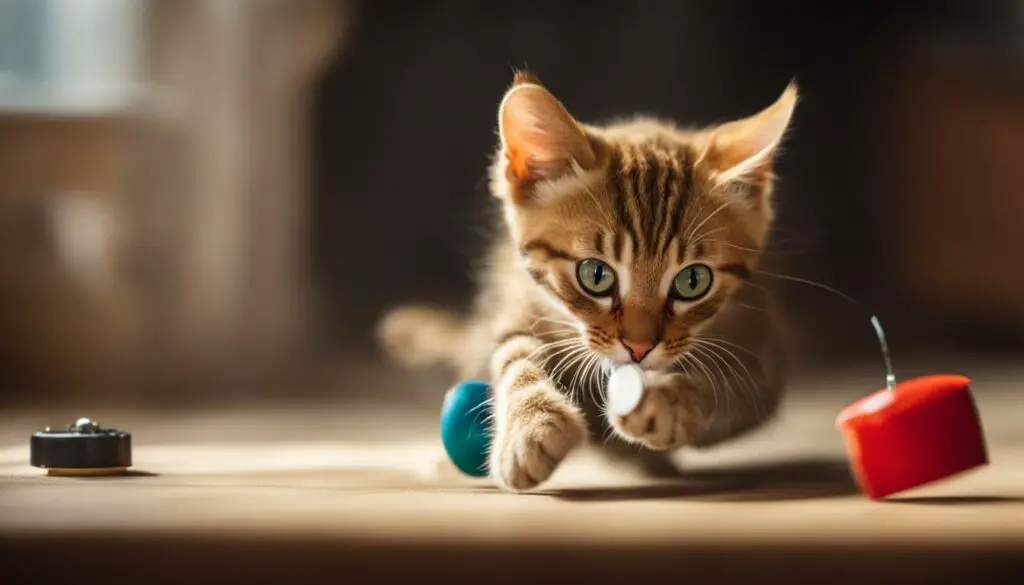
From Kittens to Seniors: How Attention Needs Vary with Life Stages
Understanding the attention needs of cats is essential for providing them with appropriate care and nurturing a strong bond. These needs can vary significantly depending on the cat’s life stage. From energetic kittens to wise senior cats, each stage brings its own set of requirements and considerations.
Kitten Attention Needs
Kittens are bundles of energy and curiosity. They require plenty of mental and physical stimulation to support their development. Playtime is crucial for kittens, as it helps them learn important social and hunting skills. Engaging them in interactive play sessions with toys and providing a variety of stimulating activities will keep them entertained and fulfilled. It’s also important to give them plenty of positive attention and bonding time to foster their trust and sense of security.
Senior Cat Attention Needs
As cats age, their attention needs change. Senior cats may have reduced mobility and energy levels, requiring more gentle and low-impact play options. They may also benefit from mental stimulation activities, such as puzzle toys or hiding treats for them to find. Additionally, senior cats often appreciate a quiet and cozy environment where they can relax and enjoy their golden years. Spending quality time with them, providing gentle affection, and monitoring their health closely are crucial for their well-being.
| Kitten Attention Needs | Senior Cat Attention Needs | |
|---|---|---|
| Playtime | High energy, interactive play sessions | Gentle and low-impact play options |
| Stimulation | Variety of stimulating activities | Mental stimulation toys and puzzles |
| Bonding | Positive attention and bonding time | Gentle affection and quality time |
| Environment | Safe and engaging environment | Quiet and cozy environment |
Understanding and meeting the attention needs of cats at different life stages is crucial for their overall well-being. By providing them with the appropriate level of mental and physical stimulation, as well as the love and attention they need, we can ensure that they lead happy and fulfilled lives.
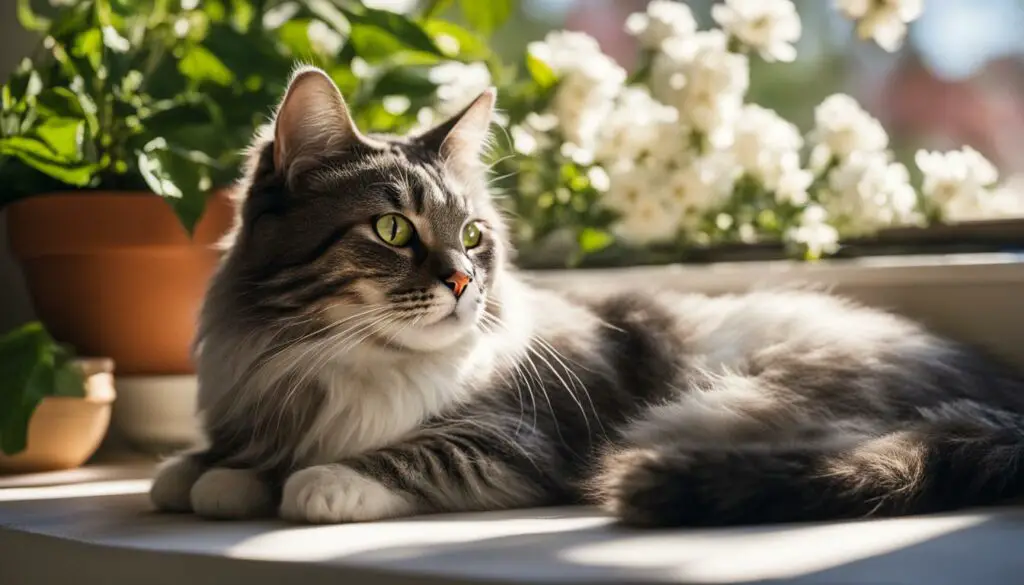
Cats’ attention needs change as they grow from adorable kittens to wise senior cats. By tailoring our interactions and environments to their specific life stages, we can create a harmonious and fulfilling experience for both cats and their human companions.
Indoor vs Outdoor Cats: Attention Differences Based on Lifestyle
When it comes to cat ownership, one important factor to consider is whether your feline friend will be an indoor or outdoor cat. The lifestyle of a cat can have a significant impact on their attention needs and overall well-being.
Indoor cats tend to require more attention and stimulation compared to their outdoor counterparts. Without the opportunity to roam and explore outside, indoor cats rely heavily on their human companions for playtime and interaction. It’s important to provide them with plenty of toys, scratching posts, and climbing structures to keep them mentally and physically engaged.
On the other hand, outdoor cats have the freedom to explore their surroundings, which provides them with a natural source of stimulation. They can engage in hunting and exploring behaviors that may not be feasible for indoor cats. However, it’s still crucial to spend quality time with outdoor cats to strengthen the bond and ensure their well-being. This can include interactive play sessions, grooming, or even just sitting outdoors together.
| Indoor Cats | Outdoor Cats | |
|---|---|---|
| Attention Needs | High | Moderate |
| Stimulation | Provided through toys, scratching posts, climbing structures, and playtime with humans | Natural stimulation from outdoor environment, hunting, and exploration |
| Supervision | Closer supervision required to ensure safety indoors | Freedom to roam with less direct supervision |
Ultimately, the decision between an indoor or outdoor cat should be based on various factors such as your living situation, the cat’s temperament, and the environment you can provide. Some cats may thrive indoors, while others may need the freedom of the outdoors. Regardless of the lifestyle you choose, dedicating time and attention to your cat is essential for their happiness and well-being.
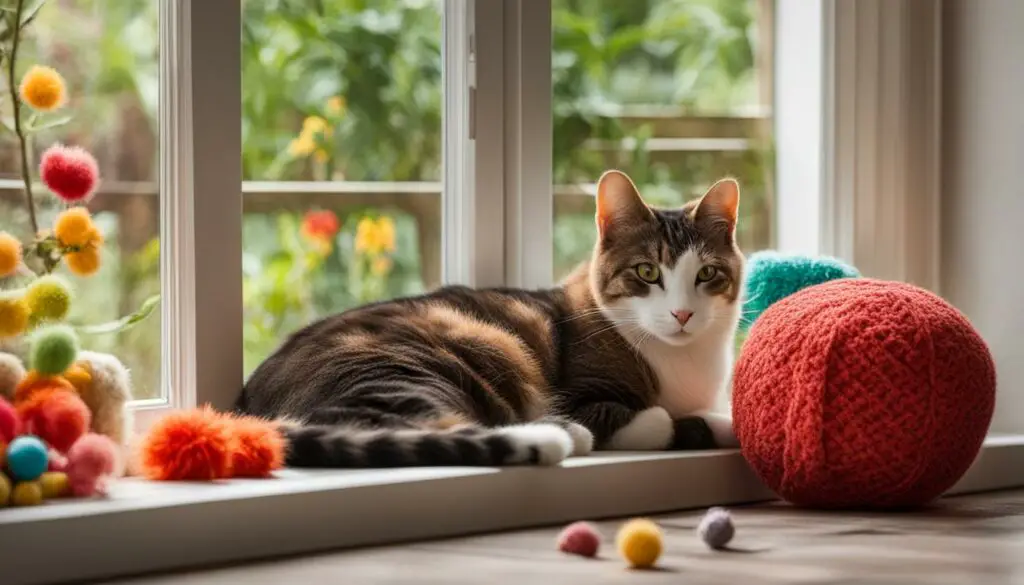
Remember, each cat is unique, and their attention needs may vary. Observing their behavior and adapting your interaction accordingly can help ensure a fulfilling and enriching relationship with your feline companion.
Signs Your Cat Wants Attention: Reading and Responding to Cat Meows
As cat owners, it’s important for us to understand how our feline companions communicate their need for attention. One of the most common ways cats seek our attention is through meowing. By paying close attention to their meows and responding appropriately, we can ensure that our cats feel heard and attended to.
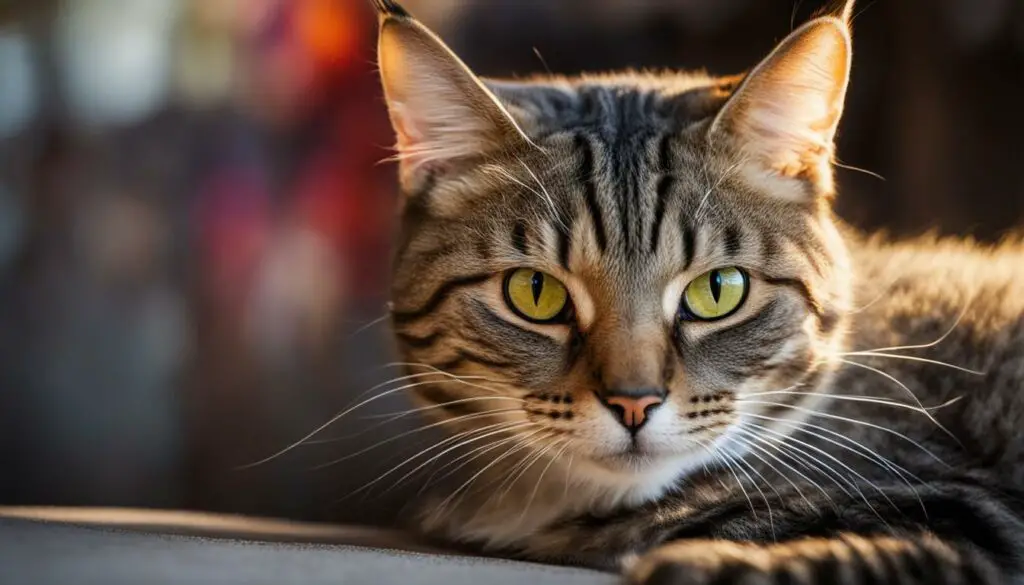
Cat communication is a fascinating aspect of their behavior. When your cat meows, it’s essential to consider the context and tone of their vocalizations. Meowing can indicate various needs, such as hunger, discomfort, or simply a desire for interaction. Observing their body language, like rubbing against your legs or arching their back, can provide additional clues to their communication.
To effectively respond to your cat’s meows, it’s important to address their underlying needs. If your cat is meowing for food, make sure their feeding schedule is consistent, and their food and water bowls are always accessible. If they are seeking attention, engage in playtime or petting sessions to fulfill their social needs. Remember, each cat is unique, so it’s important to pay attention to their individual preferences and adjust your response accordingly.
Balancing Affection and Independence: The Art of Cat Cuddling
When it comes to cat cuddling, finding the right balance between affection and independence is crucial. As cat owners, we want to shower our feline friends with love and attention, but it’s important to respect their boundaries and individual preferences. Some cats may be more aloof and independent, while others crave constant affection and cuddles. Understanding and adapting to your cat’s unique needs is the key to a harmonious cuddling experience.
Creating a safe and comfortable space for cuddling is essential. Cats are sensitive creatures, and they appreciate having their own cozy spot where they can relax and feel secure. It could be a soft blanket, a cushioned cat bed, or even a designated cuddling chair. Make sure to provide a clean and inviting environment so that your cat feels at ease when snuggling up with you.

When initiating a cuddling session, let your cat take the lead. Cats have their own preferences when it comes to physical contact, so it’s important to respect their boundaries. Start with gentle strokes and observe your cat’s body language. If they seem tense or uncomfortable, it’s best to give them space and try again later. Remember, affection should always be mutual and voluntary, and forcing a cuddle session may cause stress or anxiety for your cat.
It’s also important to strike a balance between affection and independence. While cats enjoy cuddling, they also cherish their alone time. Be mindful of your cat’s signals and cues. If they decide to leave or show signs of wanting their own space, respect their boundaries and give them the freedom to roam. This will help maintain a healthy and balanced relationship with your feline companion.
The Risks of Neglecting Your Cat’s Need for Attention
Neglecting a cat’s need for attention can have serious consequences on their behavior and overall well-being. Cats are social animals and require regular interaction, mental stimulation, and affection from their owners. Failure to provide adequate attention can lead to a range of behavioral issues and health problems.
One of the most common effects of neglecting a cat’s need for attention is increased anxiety and stress. Cats thrive on routine and structure, and when they are deprived of attention, they can become anxious and exhibit signs of distress. This can manifest in behaviors such as excessive meowing, destructive scratching, urinating or defecating outside the litter box, and aggression.
In addition to behavioral issues, neglecting a cat’s need for attention can also impact their physical health. Cats that do not receive enough mental and physical stimulation may become overweight or obese, leading to a variety of health problems such as diabetes, heart disease, and joint issues. Lack of attention can also contribute to the development of urinary tract problems, as cats may hold their urine for extended periods when they are not given the opportunity to use the litter box regularly.
| Behavioral Issues | Health Problems |
|---|---|
| Anxiety | Obesity |
| Stress | Diabetes |
| Excessive meowing | Heart disease |
| Destructive scratching | Joint issues |
| Urinating or defecating outside the litter box | Urinary tract problems |
| Aggression |
“Neglecting a cat’s need for attention can have serious consequences on their behavior and overall well-being.”
It is important to remember that cats are not solitary creatures and thrive when they have a strong bond with their owners. Regular attention and affection are essential for their emotional well-being. Spending quality time with your cat, engaging in play sessions, and providing environmental enrichment can help prevent behavioral issues and keep your cat healthy and happy.
The Importance of Attention for Cats
Attention is a crucial aspect of cat care, and neglecting this need can lead to a range of negative consequences. Understanding the risks of neglecting a cat’s need for attention can help you prioritize their well-being and provide them with the love and care they deserve.
Expert Advice: Tips from Feline Behaviorists
When it comes to understanding and meeting a cat’s attention needs, feline behaviorists offer invaluable insights. These experts have dedicated their careers to studying feline behavior and can provide guidance on creating a fulfilling and harmonious relationship with your cat. Here are some expert tips for cat owners:
- Establish a routine: Cats thrive on predictability, so creating a consistent daily routine can help them feel secure and reduce anxiety. Set regular times for feeding, playtime, and rest, and stick to it as closely as possible.
- Provide mental stimulation: Cats are intelligent creatures that need mental stimulation to thrive. Offer puzzle toys, interactive play sessions, and environmental enrichment to keep their minds sharp and prevent boredom.
- Offer a variety of attention outlets: Cats have different preferences for receiving attention. Some may enjoy lap cuddles, while others prefer interactive play or grooming sessions. Pay attention to your cat’s cues and provide them with the type of attention they enjoy most.
- Understand body language: Feline behaviorists can help you decipher your cat’s body language, enabling you to better understand their needs and emotions. Learning to read signs of comfort, stress, and contentment can improve your communication with your cat.
“Each cat is unique, and it’s important to approach their attention needs with an open mind and adapt to their individual preferences. Building trust and understanding between you and your cat is a process that requires patience and observation.”
– Dr. Emily Stevens, Certified Feline Behavior Consultant
By incorporating these expert tips into your daily interactions and understanding your cat’s attention needs, you can create a strong bond and ensure their overall well-being. Remember, every cat is different, so it’s essential to be responsive and adaptable to their individual requirements.
Expert Advice in Action: Sample Daily Routine for a Cat
| Time | Activity |
|---|---|
| 8:00 AM | Feed breakfast |
| 8:30 AM | Interactive play session (e.g., feather wand toy) |
| 10:00 AM | Independent playtime with puzzle toys |
| 12:00 PM | Offer a cozy resting spot with a view |
| 2:00 PM | Provide a scratching post and encourage play |
| 6:00 PM | Feed dinner |
| 7:00 PM | Lap cuddle and grooming session |
| 9:00 PM | Interactive play session (e.g., laser pointer) |
| 10:30 PM | Provide a comfortable sleeping area |
This sample daily routine provides a structure that promotes a balanced and fulfilling lifestyle for your cat. However, it’s important to tailor the activities and timings to suit your cat’s individual needs and preferences.
Keeping Your Cat Entertained: The Importance of Play Enrichment
When it comes to keeping our feline friends happy and healthy, providing them with ample play enrichment is essential. Cats are natural hunters, and play provides them with mental stimulation, physical exercise, and an outlet for their natural instincts. Whether it’s through interactive play with their human companions or engaging with toys on their own, playtime is a vital part of a cat’s daily routine.
One way to enrich your cat’s playtime is by offering a variety of cat toys. Different types of toys can stimulate different senses and engage your cat’s hunting instincts. Interactive toys, such as wand toys or laser pointers, allow you to engage in playtime with your cat, mimicking the movements of prey and encouraging them to chase and pounce. Puzzle toys and treat dispensers are also great options to provide mental stimulation, as cats have to figure out how to access the treats hidden inside.
Another aspect of play enrichment is creating an environment that encourages exploration and activity. This can include providing cat trees or shelves for climbing, scratching posts for satisfying their natural urge to scratch, and hiding spots for them to retreat to when they need some alone time. Additionally, incorporating vertical spaces and window perches can give cats a chance to observe the world from a higher vantage point, stimulating their curiosity and providing entertainment.
Benefits of Play Enrichment for Cats
- Physical exercise: Engaging in play helps cats burn off excess energy, preventing obesity and related health issues.
- Mental stimulation: Playtime stimulates your cat’s mind, keeping them mentally sharp and preventing boredom.
- Bonding with humans: Interactive play strengthens the bond between cats and their human companions, fostering trust and companionship.
- Stress relief: Play can help alleviate stress and anxiety in cats, providing an outlet for pent-up energy and frustration.
- Prevent behavioral issues: Regular play can help prevent common behavior problems in cats, such as aggression or destructive behavior.
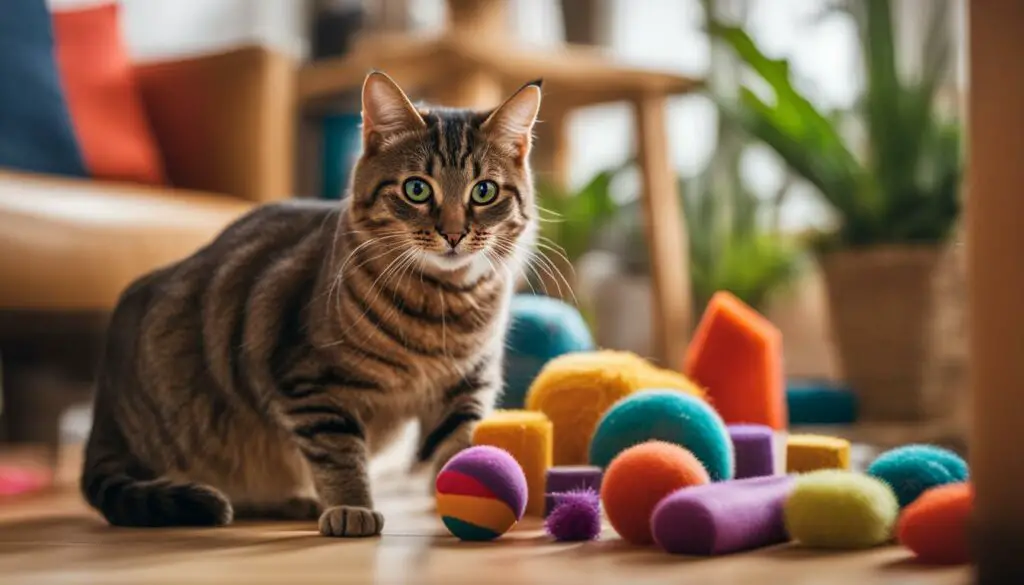
Table: Popular Types of Cat Toys
| Toy Type | Description |
|---|---|
| Wand Toys | Interactive toys with a rod and dangling object that mimic prey movements |
| Interactive Treat Toys | Toys that dispense treats when manipulated by the cat |
| Puzzle Toys | Toys that require the cat to figure out a puzzle to access treats or toys inside |
| Balls with Bells | Small balls with bells inside that cats can chase and bat around |
| Feather Toys | Toys with feathers attached to them that mimic birds or other prey |
| Interactive Laser Pointers | Handheld devices that emit a laser light for cats to chase |
Anecdotes and Fun Stories: When Cats Demand Attention
As a cat owner, I have witnessed some truly amusing and endearing moments when my feline companion demands attention. Cats have a unique way of expressing their desire for interaction, and their behavior can range from adorable to downright hilarious. Here are a few funny cat stories and quirks that highlight their attention-seeking tendencies.
Cat Craziness at 3 A.M.
One night, while I was fast asleep, I suddenly woke up to the sound of my cat zooming around the house like a tiny tornado. Furniture was knocked over, curtains were torn down, and I found my feline friend frantically chasing her own tail. It turns out she had decided that 3 a.m. was the perfect time for a late-night play session. Needless to say, I had to adapt my sleep schedule to accommodate her bursts of energy.
My cat loves to interrupt my Zoom meetings by walking across the keyboard or sitting on my laptop. It’s both adorable and embarrassing!” – Julia
The Lap Rivalry
Every evening, as soon as I sit down on the couch to relax, my cat instantly appears out of thin air, ready to claim her rightful spot on my lap. It’s as if she has a sixth sense for detecting when I want to sit down. However, if anyone else dares to invade her territory and sit beside me, she becomes the queen of jealousy. She will give them the most piercing stare and attempt to push them away, making it clear that my lap is reserved for her and her alone.
These are just a couple of examples of the quirky ways cats demand attention. Whether it’s knocking over objects, meowing incessantly, or strategically placing themselves in the middle of your work, cats certainly know how to make their presence known.
Table: Funny Cat Stories – Quirks and Demands
| Story | Quirk | Demand |
|---|---|---|
| Zoom Meeting Intruder | Interrupting Zoom meetings | Seeking attention |
| Midnight Madness | Engaging in wild play at night | Playtime at unconventional hours |
| Lap Monopoly | Claiming ownership of the lap | Preventing others from sharing the space |
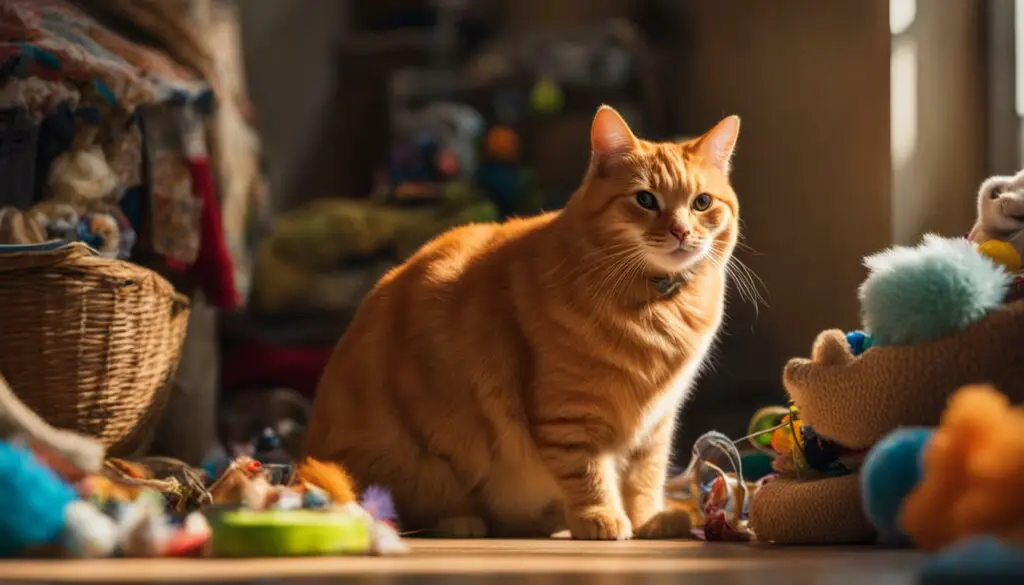
These anecdotes and stories showcase the entertaining and sometimes mischievous nature of cats when it comes to seeking attention. It’s important to remember that every cat has its own unique personality and quirks. Paying attention to their cues and providing them with the interaction they need will not only strengthen the bond you share but also create many memorable moments filled with laughter and joy.
Finding Your Own Pace with Your Cat
When it comes to owning a cat, finding the right balance in meeting their attention needs is essential. Each cat is unique, with individual preferences and requirements for stimulation and affection. It is our responsibility as cat owners to understand and respect their needs, creating a harmonious relationship that allows both the cat and the owner to thrive.
One key aspect of finding balance with cats is recognizing their individual attention needs. Some cats may prefer more interaction and playtime, while others may enjoy quieter moments of solitude. It’s important to observe your cat’s behavior and cues, allowing them to guide you in understanding their preferred level of attention. By aligning with their needs, you can create an environment that promotes their overall well-being.
Ownership of a cat is a journey that requires patience and adaptability. As your cat’s needs may change over time, being open to adjusting your routine and providing additional attention when necessary is crucial. Remember that the relationship with your cat is built on trust and understanding, and finding a pace that works for both of you will strengthen that bond.
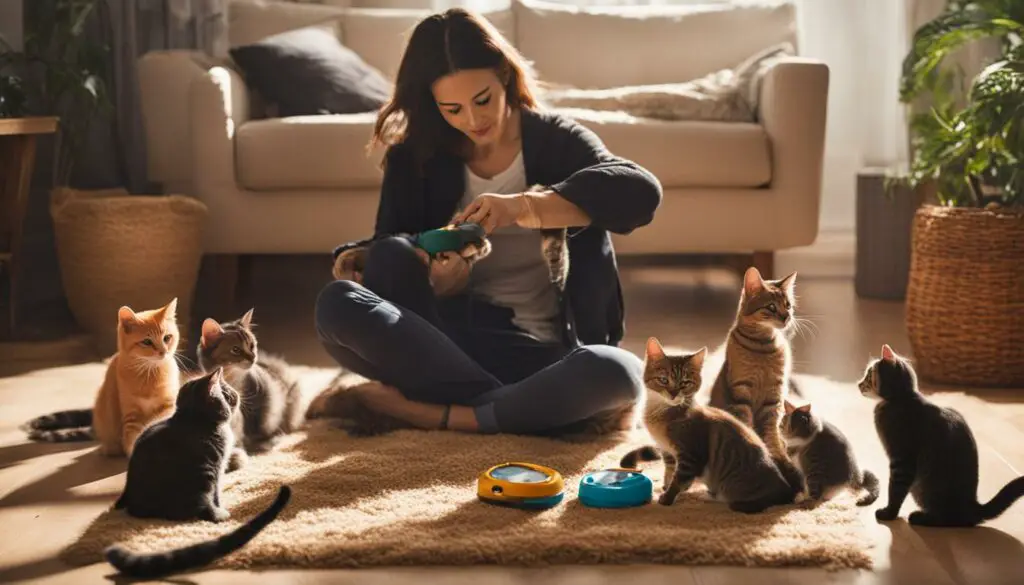
Creating a Routine
Establishing a consistent routine can help provide a sense of security for your cat and ensure their attention needs are met. Set aside dedicated time each day for interactive play, grooming, and quality bonding time. By incorporating these activities into your daily schedule, you can create a predictable and enriching environment that your cat will thrive in.
Enriching the Environment
Providing a variety of toys, scratching posts, and interactive puzzles can help keep your cat mentally stimulated and entertained. Cats need outlets for their natural instincts, such as hunting and exploring. By enriching their environment, you can prevent boredom and destructive behavior, allowing your cat to channel their energy in a positive way.
Seeking Professional Guidance
If you find it challenging to determine the optimal level of attention and care for your cat, seeking guidance from a professional, such as a feline behaviorist, can be beneficial. These experts can provide personalized advice based on your cat’s specific needs and behaviors, helping you navigate any challenges and ensure your cat’s well-being.
| Benefits of Finding Balance with Your Cat |
|---|
| • Promotes your cat’s mental and emotional well-being |
| • Strengthens the bond between you and your cat |
| • Reduces the risk of behavioral issues |
| • Enhances the overall quality of life for both you and your cat |
Remember, finding your own pace with your cat is a continuous process of learning and adapting. By prioritizing their individual attention needs and providing a nurturing environment, you can create a fulfilling and rewarding relationship with your feline companion.
Final Tips: Should I Get a Cat If I Have a Full-Time Job?
If you’re considering getting a cat but have a full-time job, you may be wondering if it’s feasible to provide the care and attention they need. While cats are independent creatures, they still require daily interaction and stimulation to thrive. With the right approach and a little extra effort, it is possible to have a happy and well-cared-for cat even if you work full-time.
Firstly, it’s important to consider the age and energy level of the cat you’re planning to adopt. Kittens and younger cats tend to have higher activity levels and may require more playtime and attention. If you work long hours, adopting an adult or senior cat with a calmer disposition might be a better fit.
Creating an enriching environment for your cat is crucial, especially when you’re not at home. Provide plenty of toys, scratching posts, and climbing structures to keep them entertained and mentally stimulated. Puzzle toys and treat-dispensing toys can also help keep your cat engaged and occupied while you’re away.
| Tip | Description |
|---|---|
| 1 | Establish a routine: Cats thrive on consistency, so try to stick to a regular feeding, play, and sleep schedule. |
| 2 | Consider adopting a companion: If your schedule allows for it, having two cats can provide companionship and keep them entertained. |
| 3 | Hire a pet sitter or enlist the help of a trusted friend or family member to check on your cat and provide playtime and attention during the day. |
| 4 | Invest in interactive toys and puzzles: These can help keep your cat mentally stimulated and entertained while you’re at work. |
Remember, cats are adaptable creatures and can adjust to your schedule. By providing them with a stimulating environment, establishing a routine, and ensuring they have companionship and attention, you can create a happy and fulfilling life for your feline friend, even if you work full-time.

Mythbusters: Can Cats See Ghosts and Angels?
One of the enduring mysteries surrounding cats is their supposed ability to see the unseen. Many people believe that cats have a sixth sense that allows them to perceive paranormal activity, including the presence of ghosts and angels. But is there any truth to these claims, or are they simply the stuff of legend and superstition? Let’s delve into the fascinating world of feline perception and explore what science has to say about cats and the supernatural.
While there is no scientific evidence to prove definitively that cats can see ghosts or angels, their behaviors and reactions may lead us to wonder. Cats are highly perceptive animals with exceptional senses, particularly when it comes to hearing and seeing movement in low-light conditions. It is possible that their keen senses could make them more attuned to subtle sounds, movements, or energy shifts that humans may not perceive, leading to their seemingly mysterious behavior.
However, it is important to approach these beliefs with a healthy dose of skepticism. Cats are curious creatures and may react strongly to unusual sights or sounds due to their instinctual nature. Their behavior may be a response to something completely ordinary and explainable, rather than the presence of supernatural entities. It is also worth considering that some cats may exhibit behaviors associated with fear or anxiety, which can be misinterpreted as reactions to the paranormal.
In conclusion, the question of whether cats can see ghosts and angels remains unanswered. While cats possess remarkable sensory abilities and may exhibit behaviors that appear mysterious, there is no scientific evidence to support the claim that they have a supernatural sixth sense. It is essential to approach these beliefs with an open but critical mind, appreciating the unique qualities and sensitivities of our feline companions without attributing them to paranormal phenomena.

Conclusion: Understanding Cat Behavior and Time Perception
In conclusion, exploring the fascinating world of cat behavior and their perception of time deepens our understanding of our feline companions. By delving into their unique nature, we can better comprehend their concept of time and how it influences their interactions with us.
Cats are often seen as independent creatures, yet they also have a capacity for affection and forming bonds with their human companions. This duality highlights their ability to experience time in their own distinct way.
Understanding the attention needs of cats is vital in providing them with the care they require. From recognizing the variations in attention needs throughout different life stages to catering to the specific needs of indoor or outdoor cats, adapting our approach ensures their well-being.
By recognizing the risks of neglecting a cat’s need for attention, we can actively strive to meet their needs and prevent potential behavior issues. With expert advice from feline behaviorists, we gain valuable insights into providing appropriate attention and care for our beloved feline friends.
Overall, finding the right balance in meeting our cat’s attention needs is a personal journey. Each cat is unique and requires individualized attention and care. By understanding their behavior and time perception, we can create a harmonious relationship filled with love, companionship, and mutual understanding.
FAQ
Do cats understand the concept of time?
While cats don’t have the same understanding of time as humans, they do have some awareness of patterns and routines in their daily lives. They can recognize when it’s time for meals, playtime, and other regular activities.
Are cats affectionate or independent?
Cats have the ability to be both affectionate and independent. They enjoy forming bonds with their human companions but also value their alone time. Each cat has its own unique personality and preferences.
How much time should I spend with my cat each day?
The amount of time you should spend with your cat depends on their age, energy level, and individual needs. On average, it’s recommended to spend at least 15-30 minutes of quality interactive time with your cat each day.
Do indoor and outdoor cats have different attention needs?
Yes, the lifestyle of a cat can impact their attention needs. Indoor cats may require more playtime and interactive toys to keep them mentally stimulated, while outdoor cats have the opportunity to explore and entertain themselves.
How can I tell if my cat wants attention?
Cats communicate their need for attention in various ways, including meowing, rubbing against you, and seeking physical contact. Pay attention to their body language and vocalizations to understand their needs.
Should I cuddle my cat or respect their independence?
Finding the right balance between giving your cat affection and respecting their independence is important. Some cats enjoy cuddling while others prefer less physical contact. Observe your cat’s cues and preferences to provide the appropriate level of affection.
What are the risks of neglecting my cat’s need for attention?
Neglecting your cat’s need for attention can lead to behavior issues such as aggression, anxiety, and destructive behavior. It can also negatively impact their overall well-being and relationship with you.
Are there any expert tips for meeting my cat’s attention needs?
Feline behaviorists offer valuable insights and tips for meeting your cat’s attention needs. They may suggest interactive toys, environmental enrichment, and specific play techniques to keep your cat mentally stimulated and engaged.
How important is play enrichment for cats?
Play enrichment is crucial for keeping cats mentally stimulated and preventing boredom. It helps satisfy their natural instincts, provides exercise, and can strengthen the bond between you and your cat.
Can cats see ghosts and angels?
There is no scientific evidence to support the claim that cats can see ghosts or angels. While cats have keen senses and may respond to stimuli that humans cannot perceive, their behavior can usually be explained by natural factors.
How can I find the right balance in meeting my cat’s attention needs?
Understanding your cat’s individual needs and preferences is key to finding the right balance. Observe their behavior, provide appropriate physical and mental stimulation, and adapt your approach based on their responses.
Can I have a cat if I work full-time?
Yes, it is possible to have a cat while working full-time. However, it’s important to consider their attention needs and make accommodations such as providing interactive toys, puzzle feeders, and arranging for social interaction during the day.
Source Links
- https://www.scientificamerican.com/article/the-inner-life-of-cats/
- https://cats.com/can-cats-see-ghosts-cats
- https://meowa.com/how-much-attention-do-cats-need/

